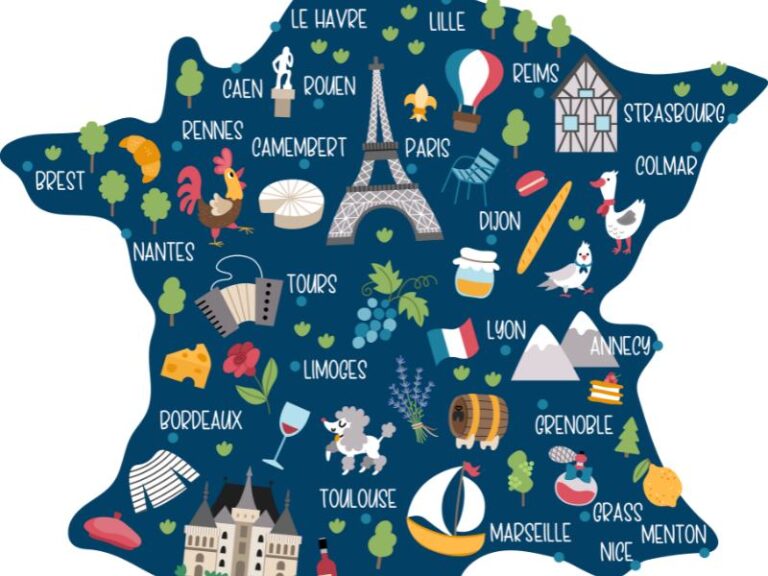As you explore the charming city of Aix-en-Provence, you’ll discover a multitude of fountains scattered throughout its neighborhoods, from the Cultural Forum (Arts District) to the Mazarin Quarter and the Vieille Ville (Old Town). These fountains serve as a reminder of Aix’s origins as a Roman spa town and add to the city’s unique charm and character.
Cours Mirabeau Fountains
Along the famous Cours Mirabeau, you’ll encounter several notable fountains:
Fontaine de la Rotonde
Located near the Tourist Information Office, the Fontaine de la Rotonde dates back to the mid-19th century. It features three statues representing Agriculture, Fine Arts, and Justice, while the base of the fountain is adorned with sculptures of children, dolphins, lions, and swans.
Small Fountains at Cours Mirabeau Entrance
Just steps away from the Rotonda, at the entrance to Cours Mirabeau, you’ll find two statues set back from small ground-level fountains.
Fontaine des Neufs Canons
Built in 1691 as the Fontaine Saint Lazare, this fountain was later renamed the Fontaine des Neufs Canons (Fountain of the Nine Canons) in 1761. It served as a water source for local religious communities before being used as a watering trough for livestock.
Fontaine d’Eau Chaude
The Fontaine d’Eau Chaude, or Fountain of Hot Water, was the first fountain built on the Cours Mirabeau in the mid-17th century. It takes its name from the thermal water sourced from the hot springs of Bagniers. The fountain’s nickname, ‘moussue’, refers to the moss that covers it. You can find this fountain at the intersection of Cours Mirabeau and Rue Clemenceau.
Fontaine du roi René
This impressive marble fountain on Cours Mirabeau features a statue of King René of Anjou, created in 1822 by sculptor David d’Angers.
Old Town Fountains
In the Old Town, you’ll discover the Fontaines de la Vieille Ville, which include:
Fontaine Place d’Albertas
Located in the courtyard of l’Hotel d’Albertas, this grand fountain was constructed in 1912 by students from the School of Arts and Crafts.
Fontaine de l’Hôtel de Ville
This fountain, situated in the square outside of City Hall (Hôtel de Ville), was built in the mid-18th century. At its center stands a Roman column discovered in the remains of the Palais Comtal, the former residence of the Counts of Provence.
Fontaine Bellegarda
Also known as Fontaine Granet, this 19th-century fountain is located in Place Bellegarda and features an ancient column topped by a bust of painter Francois-Marius Granet.
Fontaine des Augustins
The Fontaine des Augustins, located in Place des Augustins (at the intersection of Rue de la Couronne and Rue Espariat), is a 19th-century fountain that replaced a previous one erected in the 17th century near the site of the Augustinian Convent. The current fountain features a Roman column from the Palais Comtal topped by a 12-pointed copper star.
Fontaine des Tanneurs
The Fountain of the Tanners, named for the tanneries once located in the area, dates back to 1861 and features a central stone column topped by an ornamental urn. The previous fountain on this site, in Place des Tanners, was built in 1761.
Fontaine des Bagniers
Originally located a few meters from its current location in Place des Chapeliers, the Fontaine des Bagniers is one of the oldest fountains in Aix, dating back to 1687. It was relocated and renovated in the mid-18th century and features two waterspouts. Above the spouts, you’ll find a medallion of Paul Cézanne based on a portrait by Renoir.
Other Notable Old Town Fountains
- Fontaine Jouse (Joseph) d’Arbaud: A modern cascading fountain located at the intersection of Rue Monclar, Place de Verdun, and Rue Marius Reynaud, built to commemorate Provencal poet Joseph d’Arbaud.
- Fontaine des Lumieres: This cube-shaped fountain is located at the intersection of Rue des Chaudronniers and Rue Monclar.
- Fontaine Marcelle Drutel: Dedicated to poet Marcelle Drutel, this octagonal fountain is located at Place Saint-Honoré.
- Fontaine des Trois Ormeaux: Built in the 17th century, this ornate fountain, located in Place des Trois Ormeaux, is made of stone from the quarries of Calissanne and Bibémus.
- Fontaine des Prêcheurs: Located in Place des Prêcheurs (site of a daily open-air market), this fountain features an obelisk with medallions representing Charles III, Louis XV, Louis XVIII, and Sextius around its base. Created by Jean Pancrace Chastel in 1748, the baroque fountain was destroyed in the 1790s and restored in the 1830s with the assistance of American sponsorship.
- Fontaine du rue Mignet: A simple circular fountain, northeast of the city, at the intersection of Rue Mignet, Rue Lisse Saint Louis, and Rue du Puits Neuf.
- Fontaine du Boulevard Aristide-Briand: This fountain sits between Boulevard Aristide-Briand and Rue des Menudières, at the northern edge of the Old Town.
Mazarin Quarter Fountains
In the Mazarin Quarter, you’ll come across two notable fountains:
Fontaine des Quatre-Dauphins
The Fontaine des Quatre-Dauphins, or Fountain of the Four Dolphins, is the symbol of the Mazarin Quarter. Built in 1667 and originally called fontaine Saint-Michel, this was the city’s first fountain built in a public square. Today, it is located at the intersection of Rue Cardinale and Rue du 4 Septembre.
Fontaine de Saint Jean de Malte
This simple fountain, located in the square outside of the Church of Saint John of Malta, features the Maltese cross, which is the emblem of the Knights of Malta.
As you wander through the streets of Aix-en-Provence, take the time to appreciate these beautiful fountains and the historical and artistic significance they hold. They not only provide a refreshing respite from the Mediterranean sun but also offer a glimpse into the city’s fascinating past.

